Today’s radical reversal in stocks notwithstanding, the continuing hits of liquidations are not achieving their settled ends. In purely financial terms, the entire process of liquidation is to renew a settled state. Local imbalances force restriction of financial resources (what used to be money but now is something recognizable as such but truly not money) which triggers a cascade of repositioning that either relieves the immediacy of the imbalance or takes another step further in repositioning. This is the snowball effect predicated a great deal on the scale and, perhaps more importantly, the composition of the leverage in support of it all.
Local liquidations are a troubling nuisance, but when they cannot solve the imbalance from within a localized financial space the risk of a more general liquidation rises. An analogy of our current circumstances would be junk bonds. Since junk bond positions are tied to other asset classes through the vehicles which have “invested” in them, should junk bonds as either collateral or information signals (about the soundness of the vehicle holding them) produce too much of a counter-effect, the tendency to liquidate just junk bonds is surpassed and spills over into other assets. Obviously, that has already happened.
This is why Ben Bernanke’s assertion to Congress on March 28, 2007, was dead wrong before it was ever uttered:
At this juncture, however, the impact on the broader economy and financial markets of the problems in the subprime market seems likely to be contained. In particular, mortgages to prime borrowers and fixed-rate mortgages to all classes of borrowers continue to perform well, with low rates of delinquency. We will continue to monitor this situation closely.
The point of liquidation is not credit loss or even credit risk, it is exclusively volatility. Loss is not predicated upon only default, as markets often demand current prices take those same qualities. Repo provides the perfect example of just such a reset. Prior to Bernanke’s statement, it was typical for high-rated private label MBS to trade in repo with a 3-4% haircut – meaning that for every $100 in par put up as collateral you could receive $96 or $97 in overnight funding. The haircut was in place for purely liquidity reasons having less to do with default than Bernanke could apparently imagine.














Leave A Comment